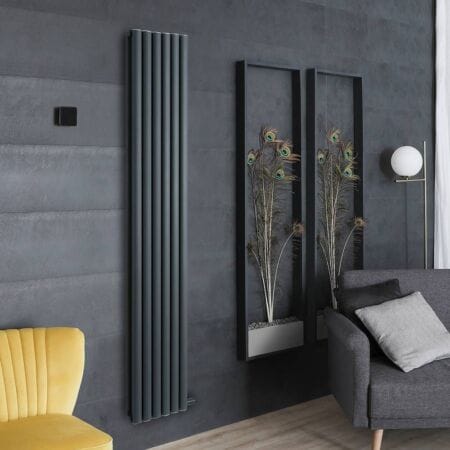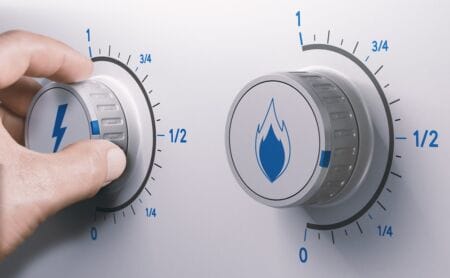Contents
ToggleWhat we'll cover...
In this guide, we’ll help you to understand how radiator depth affects heat output, efficiency, and overall room comfort. You’ll discover the key differences between 2-column, 3-column and 4-column radiators, complete with comparison tables, BTU ranges, and room-size recommendations.
We’ll also delve into electric column radiator alternatives for homes without central heating, plus share expert tips to help you select the right configuration for your space – whether you’re heating a small bedroom, a modern open-plan kitchen, or a character-filled period living room.
Understanding radiator depth and different column radiator designs
Column radiators are more than just heating heroes – they’re design statements that blend classic character with modern comfort. But with so many options available, it can be tricky to know which configuration best suits your home, and the perfect depth to choose.
Should you go slim and sleek with a 2-column radiator, opt for balance with a 3-column model, or turn up the heat with a 4-column powerhouse?
Our expert guide will help you to understand what different column configurations mean, how they affect heat output, energy efficiency, and aesthetics, and how to pick the right one for every room.
What are column radiators?
Column radiators are built from a series of hollow tubes – or “columns” – arranged in parallel rows. These tubes contain hot water that heats the surrounding air, while the space between the columns allows for airflow, fostering convection currents that transport warmth throughout the room.
Think of them as a clever mix of form and function:
- The columns provide surface area for better heat transfer.
- The gaps between the columns encourage airflow.
- The depth of the radiator determines how much heat can be generated.
In contrast to flat panel radiators, column designs offer a distinctive, three-dimensional look, which is ideal for both traditional and modern interiors alike. The more columns there are, the deeper the radiator, the greater the heat output, and the bolder the visual impact.
John Lawless, BestHeating’s digital content manager says: “Column depth isn’t just about performance. It changes the entire feel of a space – slimmer designs look clean and contemporary, while deeper ones ooze heritage charm.”
How column depth affects performance
The number of columns in a radiator affects:
- BTU output (Heat output)
- Each additional column increases the total surface area, which raises the BTU (British Thermal Unit) rating.
- More BTUs = faster and more efficient heating for larger rooms.
- Energy efficiency
- Extra columns retain heat longer after the system switches off, perfect for steady warmth.
- Fewer columns heat up quicker and cool faster, better for smaller rooms where quick bursts of heat are required.
- Style & presence
- Two-column radiators look sleek and minimalist.
- Four-column radiators feel solid and traditional, exuding old-school cast-iron charm.
- Wall projection (Depth)
- The deeper the radiator, the further it sits away from the wall.
- Always check your space prior to purchase – a 4-column radiator projects between 150 and 160mm from the wall, while a 2-column model can be positioned as close as 70mm.
2-column radiators - Best for small rooms
If you’re working with compact spaces – such as hallways, kitchens, or small bedrooms – a 2-column radiator is an excellent option.
These double-column radiators combine slim profiles with reliable heat output, making them the go-to for rooms where wall space is precious.
Why choose a 2-column radiator?
- Slim design: usually ranging from 70 to100mm deep – they barely intrude into the room.
- Quick heat response: heat up quicker than deeper designs.
- Modern look: clean lines and minimalist styling are well suited to new build properties, flats and apartments.
- Efficient for small spaces: lower water volume = lower running costs.
Example Model | BTU Range | Ideal Room Size | Finish Options | Best For |
Milano Windsor 2-Column (White) | 2,000-4,500 | Up to 8m² | White | Bedrooms, hallways |
Milano Windsor 2-Column (Anthracite) | 2,500-5,000 | 8–10m² | Anthracite | Compact modern rooms |
If your room feels underheated with a 2-column model, don’t panic and reach for a replacement right away. First, check your system pressure and radiator balancing first. Often, uneven heating can be caused by trapped air or misaligned radiator valves rather than radiator size.
3-column radiators - Balanced heat and style
The 3-column configuration can be seen as the sweet spot of column heating. It’s the all-rounder, delivering more warmth than a 2-column design while maintaining a slim enough projection to fit most rooms.
Perfect for living rooms, dining rooms, and larger bedrooms, these radiators provide a beautiful balance between performance and design.
- Increased BTU output: ideal for medium-sized rooms.
- Balanced wall projection: around 110-130mm in depth.
- Classic design: well suited to both traditional and modern homes.
- Great for open-plan spaces: keeps large rooms evenly heated.
Example Model | BTU Range | Ideal Room Size | Finish Options | Best For |
Milano Windsor 3-Column (White) | 3,000-8,000 | 10-18m² | White | Living rooms, dining rooms |
Milano Windsor 3-Column (Anthracite Vertical) | 3,800-8,500 | 12-20m² | Anthracite | Feature walls, open-plan layouts |
Paul Cavanagh, product procurement specialist at BestHeating: “If you’re unsure where to start, a 3-column radiator is your safest bet – it offers the flexibility to perform well in almost any room.”
4-column radiators - Maximum heat for large rooms
When only a premium heating performance will do, the 4-column radiator stands out as a heating heavyweight.
These deeper designs are perfect for open-plan areas, period properties, high-ceilinged homes, or draught-prone spaces. Their wider build holds more water, providing a powerful, consistent warmth that will stick around long after the boiler switches off.
Why choose a 4-column radiator?
- Outstanding BTU performance: perfect for large spaces or those with poor insulation.
- Deep traditional aesthetic: adds a vintage edge reminiscent of cast iron radiators.
- Efficient heat retention: stays warm for longer to ensure sustained comfort.
- Impressive presence: a statement look whilst providing an impressive heat output.
Example Model | BTU Range | Ideal Room Size | Finish Options | Best For |
Milano Windsor 4-Column (White) | 5,000-11,000 | 18-30m² | White | Living rooms, open-plan areas |
Milano Windsor 4-Column (Anthracite) | 6,000-12,000 | 20-35m² | Anthracite | Period homes, industrial décor |
“A 4-column radiator can handle tricky spaces where heat escapes quickly – like Victorian bay windows or open stairwells. It’s the heritage design with heavyweight performance.”
Column radiator configurations compared
Configuration | Typical Depth | Heat Output | Room Size | Look & Feel | Ideal For |
2-Column | 70-100mm | ★★☆☆☆ | Small (up to 10m²) | Sleek & modern | Bedrooms, hallways |
3-Column | 110-130mm | ★★★★☆ | Medium (10-20m²) | Balanced & versatile | Living rooms, kitchens |
4-Column | 140-160mm | ★★★★★ | Large (20-35m²+) | Bold & traditional | Open-plan spaces, period homes |
Calculate your exact heating requirement with our BTU Calculator.
Should you choose electric column radiators?
For homes without central heating – or where you want flexible, room-by-room heating control – electric column radiators offer an ideal solution.
They combine the timeless Windsor column aesthetic with modern electric heating technology.
Benefits of electric column radiators
- No pipework or plumbing: simply plug in and go
- Independent heating zones: heat the rooms you use only for an efficient performance
- Same stunning design: all the heritage charm, powered by electricity
- Energy-efficient operation: ideal for well-insulated modern homes
Model Example | Wattage | Equivalent BTU | Ideal Room | Best For |
Milano Windsor Electric 2-Column | 600-1,000W | 2,000-3,400 BTU | Bedroom / hallway | Small rooms or secondary heating |
Milano Windsor Electric 3-Column Vertical | 800-1,500W | 2,700-5,100 BTU | Living room / office | Homes without central heating |
How to choose between 2, 3 and 4-column radiators
Choosing the right configuration is an easy process when you follow a few key steps.
Step 1: Measure your space
Use our radiator sizing guide to calculate the BTU output requirement for each room.
Step 2: Check your layout
- Small walls? Opt for 2-column designs.
- Medium rooms? Pick a 3-column radiator for balance.
- Large open-plan or period rooms? Select a 4-column model.
Step 3: Match your style
- Modern minimalist: Anthracite 2-column radiator
- Balanced décor: White 3-column radiator
- Classic heritage: 4-column design in black or raw metal finish
Step 4: Consider efficiency
More columns = more heat retention. If you value quick bursts of warmth throughout the space, a 2-column radiator is a more reactive option. For consistent background heat, choose 4 columns.
Find your perfect column radiator with BestHeating
Finding the right radiator depth can transform both your comfort and your décor. Whether you’re modernising a flat or restoring a Victorian home, there’s a stylish column radiator designed to perfectly enhance your space.
And there’s no better time to invest with Black Friday deals now live, offering up to 30% off selected heating and an extra 10% off orders over £500 with voucher code SAVE500.
Explore the full collection online at BestHeating, and don’t forget to show off your column radiator glow-ups through our social channels on Instagram, Facebook or X.
Frequently Asked Questions
Is a 2-column radiator enough for a bedroom?
Yes. For rooms sized up to around 10m², a 2-column model will deliver an adequate level of warmth. If your bedroom has high ceilings or poor insulation, consider a 3-column design for extra output.
What’s the difference between a 3-column and 4-column radiator?
A 4-column radiator has greater depth and holds more water, producing added heat and retaining it for longer. A 3-column radiator offers a balanced performance with a slimmer profile.
Do column radiators use more energy than panel radiators?
Not necessarily. Whilst column radiators hold more water, their radiant heat efficiency means they often run shorter cycles in order to reach target temperatures.
Can I get an electric version of a 3-column radiator?
Yes – the Milano Windsor electric collection includes both 2 and 3-column options with built-in smart thermostats for precise control.
John is a Research Specialist for the Best Heating Advice Centre, where for over nine years he has dedicated himself to demystifying home heating for our customers. He specialises in creating clear, data-driven guides and how-to articles by collaborating directly with our team of certified heating experts and product engineers.
His work, built on a foundation of journalistic research, has helped millions of readers make confident and informed decisions about their home heating. When he’s not breaking down the heat output differentials from radiators to heated towel rails, John fancies himself as a fine football and music connoisseur.












